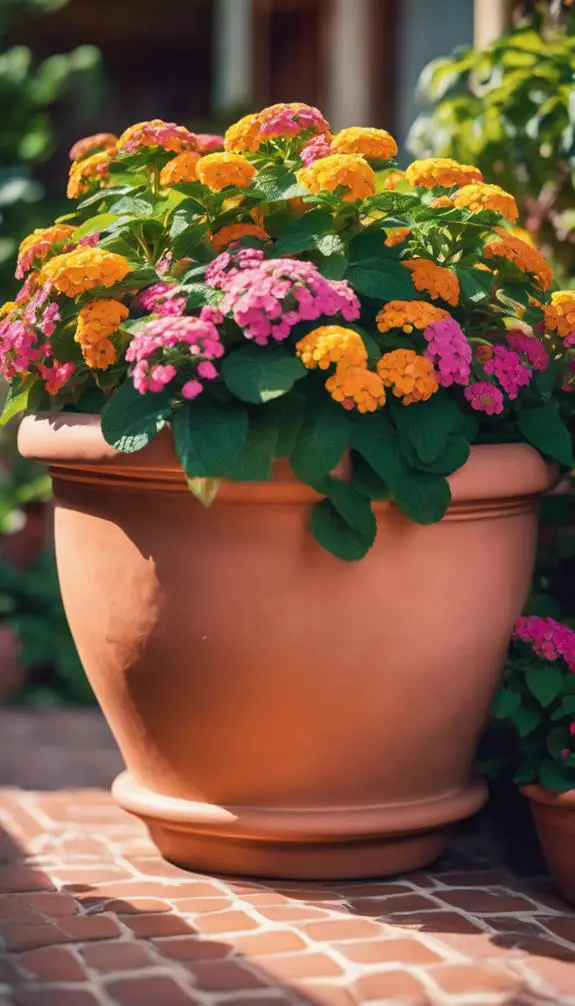You're about to discover the secrets to growing crisp, flavorful green onions right in your own backyard. To get started, you'll need to choose the right variety for your climate and culinary goals. But that's just the beginning – preparing the soil, sowing the seeds, and providing the right conditions are all vital steps in the process. And what about harvesting at the peak time to maximize flavor and texture? You're probably wondering how to do it all without running into common pitfalls. Let's take a closer look at the essential steps to grow green onions that will elevate your cooking to the next level.
Summary
- Select the right green onion variety based on climate, intended use, and personal taste to ensure optimal growth and flavor.
- Prepare the soil with organic amendments like compost or well-rotted manure to improve structure and fertility, and maintain a pH between 6.0 and 7.0.
- Sow high-quality seeds at the correct depth (1-2 inches) and maintain consistent moisture, especially when young, with about 1-2 inches of water per week.
- Provide at least 4-6 hours of direct sunlight per day, and monitor the crop for pests and diseases, using organic control methods whenever possible.
- Thin onions regularly, prune them to encourage healthy growth, and harvest when they're around 6-8 inches tall and bulbs are about the size of a nickel.
Choosing the Right Onion Variety
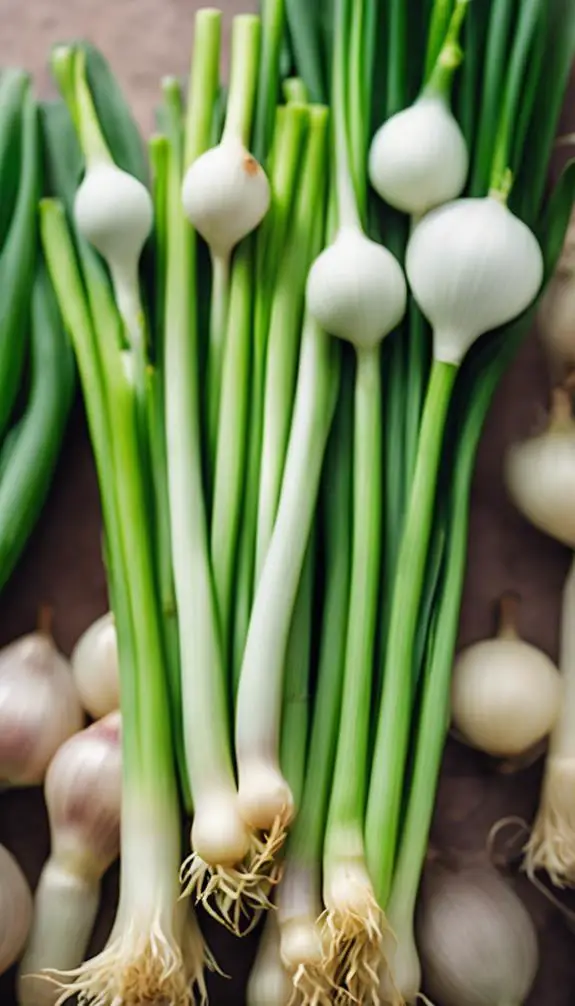
When it comes to growing green onions, selecting the right variety is crucial because it determines the flavor, texture, and growth rate of your crop.
You'll want to weigh factors like climate, intended use, and personal taste when making your choice.
For example, if you live in a hot and dry climate, you'll want a variety that's resistant to bolting, like 'Beltsville Bunching' or 'Ebenezer'.
If you're looking for a sweet and mild flavor, 'Vista' or 'Crystal Wax' might be a good fit.
Comparing different varieties will help you find the one that best suits your needs.
Make an informed decision, and you'll be on your way to growing delicious green onions that will elevate any dish.
Preparing the Soil Bed
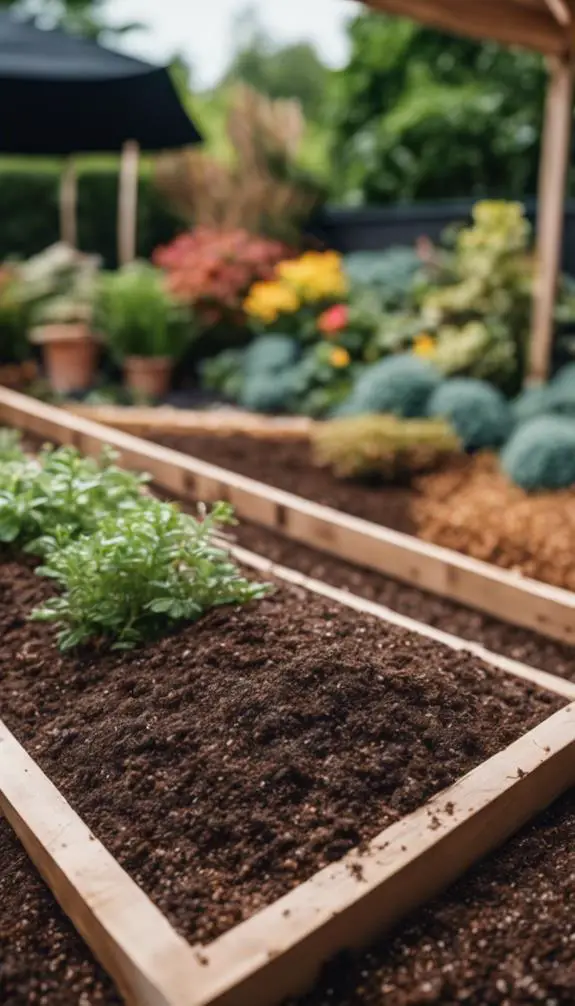
You'll want to choose a soil type that drains well, as green onions don't like wet feet.
The ideal pH level for growing green onions is between 6.0 and 7.0, so test your soil to verify it falls within this range.
If your soil is too acidic or alkaline, you can amend it with organic matter like compost or well-rotted manure to bring it to a more neutral pH.
Soil Type Matters
Before planting your green onions, take a closer look at the soil you're working with, as its type can substantially impact your harvest's success.
You'll want to assess the soil composition, considering factors like its pH level, nutrient content, and drainage.
If your soil is lacking, don't worry – you can still grow healthy green onions with the right organic amendments.
Add compost, manure, or peat moss to improve soil structure and fertility.
This will give your green onions the boost they need to thrive.
By taking the time to prepare your soil, you'll set yourself up for a bountiful harvest.
Optimal Ph Levels
Green thumbs, take heed: a soil pH between 6.0 and 7.0 is the sweet spot for green onions to flourish.
This narrow range allows your onions to absorb essential nutrients without struggling with soil acidity. pH fluctuations can be detrimental, so it's vital to monitor and adjust your soil pH regularly.
If your soil is too acidic, it can lead to stunted growth and reduced yields. On the other hand, alkaline soil can cause nutrient deficiencies.
You can test your soil pH using a DIY kit or send a sample to a lab for analysis. Based on the results, add lime to raise the pH or sulfur to lower it.
Obtaining Green Onion Seeds

Seed selection is the first hurdle in growing green onions, and vitally, you must get it right.
You want seeds that will produce high-quality onions with the right flavor, texture, and color. Look for reputable seed suppliers that specialize in green onions, as they often offer varieties bred for specific characteristics.
Check the seed packet or website for information on the onion's maturity days, disease resistance, and storage potential. Some popular varieties include 'Evergreen' and 'Beltsville Bunching'.
Sowing the Seeds Properly
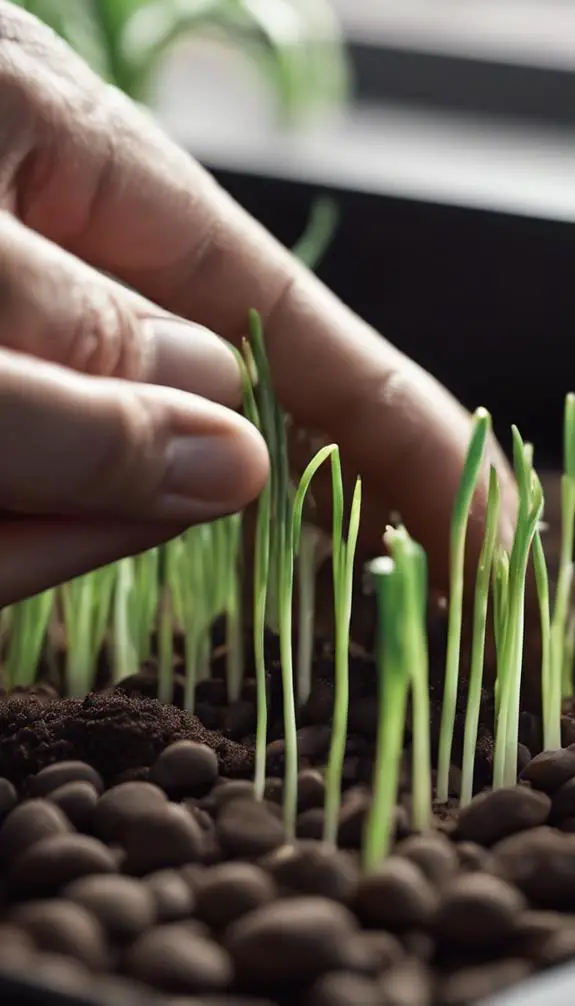
You're ready to sow your green onion seeds, and it's vital to get it right.
To give your seeds the best chance, you'll want to plant them at the correct depth – too deep and they'll struggle to sprout, too shallow and they'll wash away.
Seed Depth Matters
Your green onion's success hinges on proper sowing, and that starts with getting the seed depth just right.
You want to plant the seeds at a depth that allows them to receive adequate light while still being protected from harsh conditions. As a general rule, sow your green onion seeds about 1-2 inches deep, depending on the soil density.
If your soil is dense, you may need to plant them a bit deeper. Make sure to choose high-quality seeds that can germinate easily.
Optimal Soil Conditions
About half of the battle in growing healthy green onions is fought in the soil.
You'll want to create an environment that fosters healthy root growth, and that starts with superior soil conditions.
Guarantee your soil has good aeration to allow roots to breathe and absorb nutrients efficiently.
The ideal soil temperature for green onions is between 65°F and 75°F (18°C and 24°C), which promotes healthy germination and growth.
If your soil is too dense or heavy, mix in some organic matter like compost or well-rotted manure to improve its structure.
Watering and Providing Humidity

Green onions need consistent moisture, especially when they're young, to grow rapidly and prevent them from becoming stressed.
You'll want to establish a regular watering schedule to keep the soil consistently moist but not waterlogged. Aim to provide about 1-2 inches of water per week, either through rainfall or irrigation.
In addition to watering, you'll want to maintain ideal humidity levels around your green onions. You can do this by placing the pot on a tray filled with water and pebbles or using a humidifier nearby.
This will help keep the air around your onions moist and promote healthy growth. By keeping your onions consistently watered and humid, you'll be well on your way to a thriving crop.
Giving Adequate Sunlight

Now that you've got your green onions consistently watered and humid, it's time to focus on giving them the right amount of sunlight.
Green onions need at least 4-6 hours of direct sunlight per day to thrive. However, the ideal sunlight duration depends on your region's climate and time of year.
In warmer climates, providing some shade during the hottest part of the day can prevent scorching. Consider the solar orientation of your growing area, ensuring your green onions receive morning sun and dappled afternoon light.
If you're growing indoors, place them near a south-facing window or use grow lights to supplement natural light. By providing the right amount of sunlight, you'll be rewarded with healthy, robust green onions.
Fertilizing the Soil

You'll want to guarantee your soil has a balanced mix of nutrients to promote healthy green onion growth.
To achieve this, you'll need to select the right type of fertilizer that provides essential nutrients like nitrogen, phosphorus, and potassium.
Soil Nutrient Balance
Proper soil nutrient balance is the backbone of a thriving green onion crop, and fertilizing the soil is a crucial step in achieving it.
You want to create an environment where your green onions can absorb the nutrients they need to grow strong and healthy.
To do this, focus on improving your soil structure by adding organic matter like compost or well-rotted manure.
This will help with nutrient cycling, allowing nutrients to be released slowly and steadily as your green onions need them.
By achieving a balanced soil nutrient profile, you'll be giving your green onions the best possible start in life.
Optimal Fertilizer Types
By the time you've prepared your soil with organic matter, it's ready to receive the ideal fertilizers that will fuel your green onions' growth.
For peak results, focus on organic amendments that promote healthy microbial activity. These can include compost, worm castings, or well-rotted manure.
When it comes to nitrogen, opt for a balanced liquid fertilizer that provides a slow release of nutrients. Liquid nitrogen can be beneficial, but be cautious not to overdo it, as excessive nitrogen can lead to weak, leggy growth.
Aim for a balanced fertilizer with a nitrogen-phosphorus-potassium (NPK) ratio of 10-10-10 or 20-20-20. This will provide your green onions with the necessary nutrients for robust, flavorful growth.
Controlling Pests and Diseases
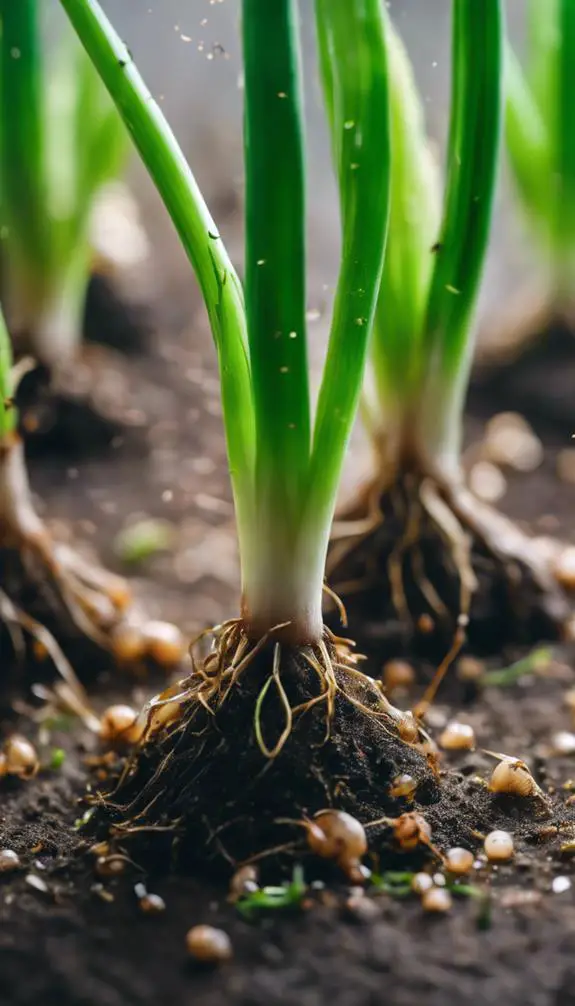
Pests and diseases can quickly ruin your green onion crop, so vigilance is vital to keep a close eye out for signs of trouble.
Start by monitoring your plants regularly, looking for telltale signs of pests like holes, discoloration, or actual insects.
You can use pest identification methods like sticky traps or bait traps to catch and identify the culprits.
Once you've identified the problem, turn to organic pest control methods like neem oil, pyrethrin, or insecticidal soap to tackle the issue.
For diseases, remove infected plants, improve air circulation, and adjust your watering schedule to prevent fungal growth.
Thinning and Pruning Onions

Now that you've protected your green onions from pests and diseases, it's time to focus on giving them room to grow.
Onion overcrowding can lead to weak and spindly growth, so thinning is essential. Use scissors to trim the onions, leaving about an inch between each plant. This will allow for better air circulation and sunlight penetration, promoting healthy growth.
As you're trimming, remove any weak or damaged onions to prevent the spread of disease. Regular onion trimming will also encourage the onions to grow bigger and stronger.
Harvesting at the Right Time

Pick your green onions at the peak of freshness to enjoy their full flavor and texture.
You'll know it's time to harvest when the onions are around 6-8 inches tall and the bulbs are about the size of a nickel. Check on them daily, as the harvest timing is vital.
If you wait too long, the onions will start to flower, which affects their flavor. Practice onion patience and harvest them when they're young and tender.
Simply snip off the green leaves at the base with scissors, leaving about an inch of stem and the small bulb intact. This will allow you to use the onions immediately, and you can store them in the fridge for up to a week.
Regrowing From Onion Scraps
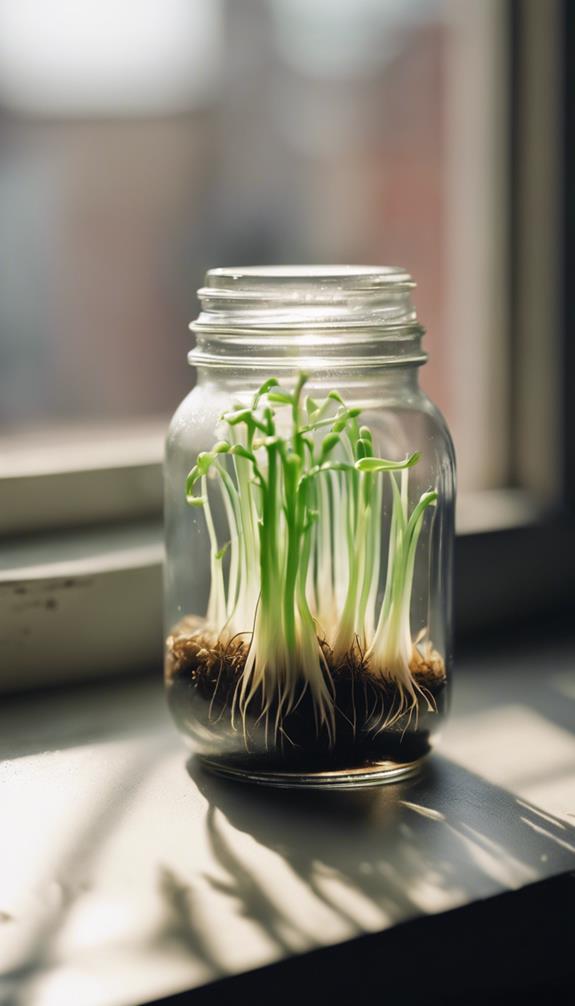
From the onion scraps you've saved, you can coax new green onions into growth, reducing food waste and saving you a trip to the grocery store.
This onion recycling technique is a great way to reuse scraps that would otherwise end up in the trash. Simply place the scraps in a glass of water, making sure the white base is fully submerged.
Keep the water level topped up and change it every few days to prevent bacterial growth. Within a week, you'll start to see green shoots emerging.
Once they're around an inch tall, transfer the onions to a pot of soil and keep them moist. With proper care, you'll have fresh green onions in no time, all from scraps you would've otherwise thrown away.
Storing Freshly Harvested Onions
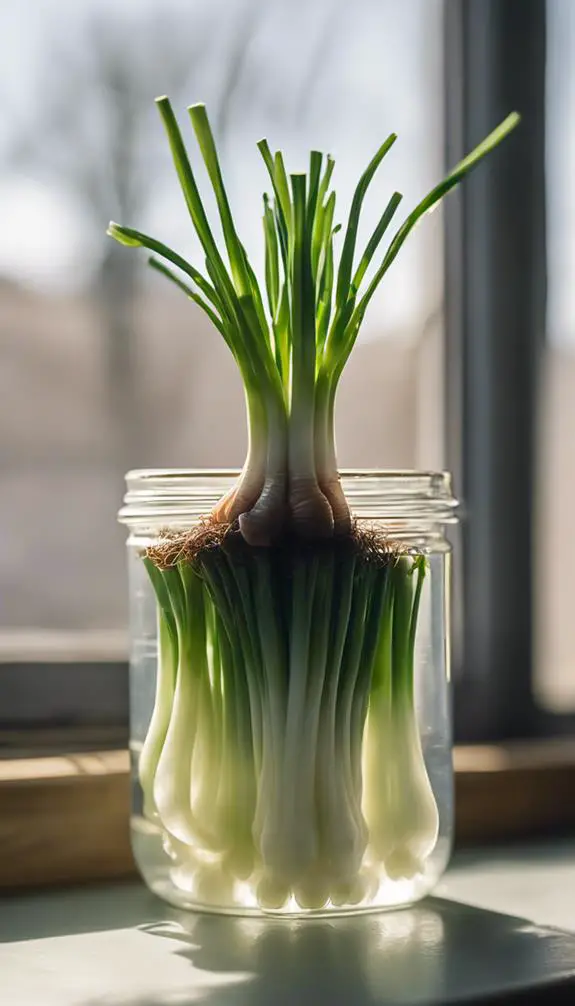
You've successfully grown your green onions from scraps, and now it's time to think about storing them to keep them fresh for as long as possible.
To maximize onion longevity, a crucial step is to store them properly.
Start by gently washing the onions to remove any dirt or debris.
Pat them dry with a clean towel or paper towels to remove excess moisture.
Then, place the onions in a breathable container, like a paper bag or mesh bag, to promote air circulation.
Store them in the refrigerator to keep them cool and humid.
Common Mistakes to Avoid
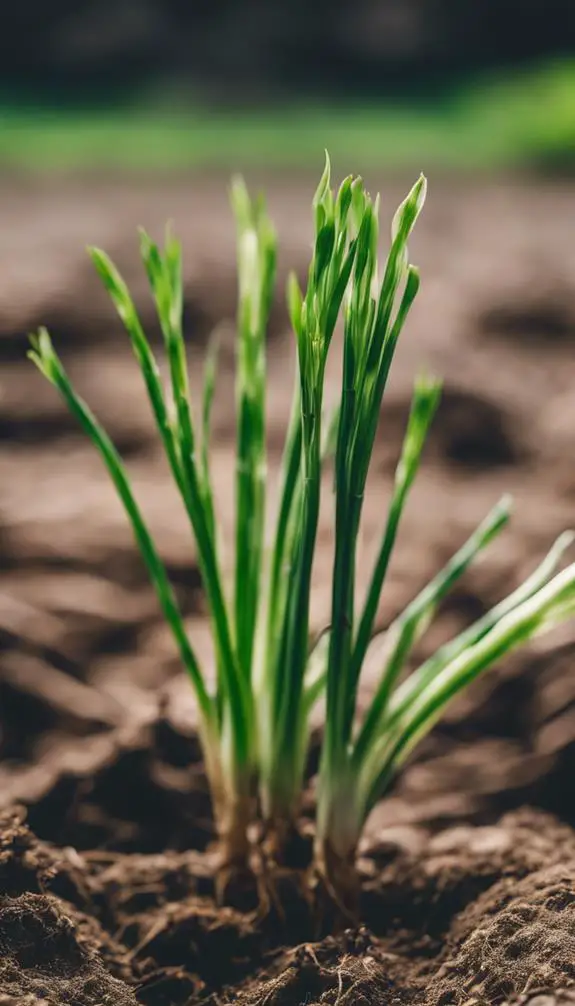
Mistakes in storing and caring for your green onions can substantially shorten their shelf life.
You might be guilty of onion neglect, leaving them in a warm, dry spot for too long. This can cause them to shrivel up and lose their flavor.
Another common mistake is overwatering, which can lead to rot and decay. Check your onions regularly to confirm they're not sitting in waterlogged soil.
Overwatering consequences can be devastating, so make sure to drain excess water and provide good air circulation.
FAQs
Can I Grow Green Onions in Pots or Containers?
You can definitely grow green onions in pots or containers, just make sure to use a well-draining container soil and add drainage holes to prevent waterlogged soil, allowing your onions to thrive in their new home.
How Long Does It Take for Green Onions to Regrow?
You'll need some onion patience, as regrowth can take around 1-2 weeks, depending on factors like light, water, and temperature. With proper care, you'll be enjoying fresh green onions again, and the regrowth timeline will get shorter with each harvest!
Can I Use Regular Onions for Growing Green Onions?
You can use regular onions, but not all varieties are ideal; look for onion varieties specifically bred for green onion production, like 'Evergreen' or 'Beltsville Bunching', and choose seeds that are disease-resistant and suitable for your climate.
Will Green Onions Grow Back if I Cut Them Too Low?
If you cut them too low, you'll reduce their chances of regrowing, so be gentle! For ideal onion care, use precise cutting techniques, leaving about an inch of the white base intact to encourage new growth.
Can I Grow Green Onions Indoors Without Sunlight?
You can grow green onions indoors without direct sunlight by placing them on window sills with indirect light or using artificial lighting, like LED grow lights, to provide the necessary illumination for healthy growth.
Conclusion
You've made it! With these simple steps, you're well on your way to growing delicious green onions. Remember to keep the soil moist, provide plenty of sunlight, and harvest at the right time. Don't be discouraged if you encounter setbacks – just adjust and keep going. Happy growing!




